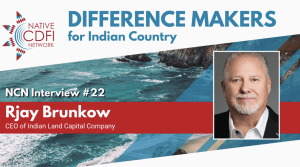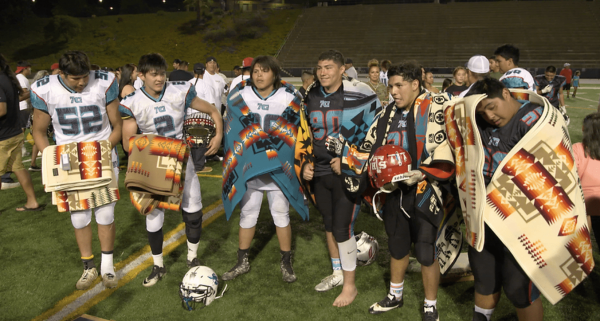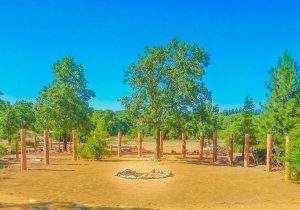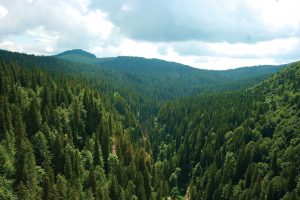HOW JAYME MURRAY IS CREATING FOOD SOVEREIGNTY FOR THE CHEYENNE RIVER SIOUX TRIBE
August 9, 2023
Long before the Cheyenne River Sioux Reservation was established in South Dakota in 1889, the people of the Lakota Nation sustained themselves off of the land, with the buffalo, or American bison, as its primary source of food. Over a century later, tribal ties to the sacred animal still run strong. The Cheyenne River Sioux Tribe and its retail operation, the Cheyenne River Buffalo Company, are creating new opportunities for economic development, expansion, and sustainability for the Native American community.
At the helm of the Cheyenne River Buffalo Company is Jayme Murray, a sixth generation rancher on Cheyenne River, who grew up on a cow-calf ranch in the area before attending South Dakota State University and working at the Bureau of Indian Affairs for almost 20 years. During his tenure with the organization, he held several roles, ranging from managing all the trust lands on the reservation to serving as the Fiduciary Trust Officer for the Office of the Special Trustee for American Indians.
In 2019, The Cheyenne River Sioux Tribe approached Jayme with an offer to take over the management of their buffalo corporation, a business corporation which operates independently of, but is owned by, the tribe. For Jayme it was a perfect opportunity to bring his expertise to an organization near and dear to his heart.
The Cheyenne River Buffalo Company already owned a herd of 450 bison when Jayme came on, but he was quickly tasked with growing the organization and their profits. The company had a vision of being better able to grow, process, and market their products under their own label on the retail side. But there was more to this vision of growth than just finances; the Cheyenne River is one of the most economically distressed areas in the United States, where unemployment rates run as high as 80%. As a non-gaming tribe, The Cheyenne River Sioux had to seek out other avenues to develop economically.
“We have had to lean on what we do have,” said Jayme. “We have agriculture, and we have buffalo, and we have beef that’s some of the best in the world. And if we’re going to stimulate economic growth here at home, it needs to be through what we’re able to do better than anyone.”
In July of 2019, a golden opportunity presented itself which Jayme knew they couldn’t pass up: a local slaughter facility and associated real estate property went on sale on the border town of the reservation. Jayme knew that purchasing it would allow his team to increase the size of the herd and scale production to meet demand from local restaurants and butchers.
The CDFI Difference
Jayme and his colleagues faced a significant hurdle to purchase the facility and surrounding land—financing.
To begin, the Cheyenne River Buffalo Company explored some traditional lenders. Jayme put together a pitch and a business plan, which, according to him, the lending teams did not even look at. “It was an issue of collateral,” Jayme explained. “This was a new venture for us. While we had profit and loss statements and tax returns, we were still essentially trying to borrow based on projections.”
Jayme reached out to Cris Stainbrook, President of the Indian Land Tenure Foundation, who he had worked with on several occasions. He provided the company’s business proposal and plan, and the Foundation immediately stepped in to help. First, they provided Jayme’s team with an attorney, who had experience working on similar projects. “That was very helpful for us because we were already having to put up quite a bit of capital of our own to make this all happen,” said Jayme. “That provided an opportunity to save a little bit and make sure everything from the due diligence to the purchase agreement documents were done properly.”
The Foundation also put Jayme in touch with the Indian Land Capital Company (ILCC), a Native-owned CDFI they had created in 2005 to provide alternative loan options to Native Nations for tribal land acquisition and economic development projects. CNote partners with CDFIs like The Indian Land Capital Company across the country through its customized impact investment offerings that allow corporations to invest in a portfolio of CDFI loan funds selected to meet their impact-aligned goals and to improve their performance on thematic ESG measures.
Jayme could instantly tell the difference between the traditional lenders he had attempted to work with in the past and ILCC. “Their approach as a CDFI really made a difference. They looked outside the lines a little more than conventional lenders and were able to work through a few kinks to support the Cheyenne River Buffalo Company.”
Despite slowdowns due to COVID, the Cheyenne River Buffalo Company was able to close on the property and facility on February 1st of 2021, with $3M in financing from ILCC. As an added bonus, Jayme was able to retain all of the original equipment, inventory, and employees from the slaughter facility. “The facility closed down on Friday and then opened on Monday morning with us as the owners. If you didn’t know that we had bought it, you wouldn’t have even noticed the difference.”
Local Impact with International Interest
Despite the incredible effort it took to purchase the new land and facility, there was no time for Jayme and his team to rest. Initially, the Cheyenne River Buffalo Company was a direct to consumer business, whose biggest clients were local Native American restaurants and butchers. With time, however, Jayme had seen skyrocketing demand from domestic organizations as large as the Department of Defense and internationally from companies in the Middle East and Singapore. To keep up with this heightened demand, the company ballooned to owning over 1100 bison and now is getting ready to launch an online sales portal to enable consumers to more easily purchase their products from anywhere.
Jayme’s motivation still ran deeper than just the growth of the company. COVID had exposed the volatility of food supplies, and what had started as a financial venture for the company had turned into a personal mission of food sovereignty. His goal is not only to become the premier buffalo meat company in the world, but also to put those products on local shelves to be made available for everyone in The Cheyenne River Sioux Tribe.
“At the end of the day our goal would truly be to make our buffalo and locally sourced beef products available to all of our people. If we could do that, that would be a success. We have visions of being the premier meat company in the world, and we have the story; I mean, this animal is closer to us than to anyone else. I think there’s room for us to continue to grow and continue to be a resource to other tribes. It feels like the potential for growth just keeps reaching further and further.”
See the original blog post and photos at https://www.mycnote.com/blog/cheyenne-river-buffalo-company/
————————————————
INDIAN LAND CAPITAL COMPANY REPORTS RECORD FUNDING
Investment in Native-owned lender has increased by more than 40 percent
May 17, 2023
Little Canada, Minn. – The Indian Land Capital Company (ILCC) today reported a 40 percent increase in funding for 2023 from a variety of sources, major investments that will lead directly to more economic development opportunities for tribal communities across Indian Country. The $5.2 million in funding received is the most the organization has garnered in a single year since its inception in 2005.
ILCC is a Certified Native Community Development Financial Institution (CDFI) providing alternative loan options to Native Nations for tribal land acquisition projects. Its goal is to help restore land within reservation boundaries to Native American ownership and control. ILCC is owned by the nonprofit Indian Land Tenure Foundation. Recent funding awards came from several sources, including:
- $1,000,000 from the U.S. Department of Treasury’s fund for CDFIs
- $300,000 from U.S. Department of Treasury’s Persistent Poverty County program
- $3,602,000 from the U.S. Department of Treasury’s Equitable Response program
- $300,000 from the Opportunity Finance Network
“We are excited about what this means for Indian Country,” said Rjay Brunkow, Chief Executive Officer of ILCC and an enrolled member of the Turtle Mountain Band of Chippewa Indians. “The money will be used to fund a land purchase for Oglala Sioux in South Dakota and a land acquisition for the Buena Vista tribe in California that is developing an RV park.”
As a Native-owned and operated business, ILCC understands the unique needs of Native Nations and creates customized, flexible loan packages. ILCC takes a unique approach to tribal financing that has made the organization the premier lender in Indian Country. By lending on a “full faith and credit” basis, ILCC recognizes the sovereign status and business acumen of tribes.
“We have more than $50 million in shovel-ready projects in our pipeline,” said Brunkow. “These investments will help more of these come to fruition. In the bigger picture, we plan to leverage this $5 million investment into $20 million of borrowed funds to do even more projects in Indian Country. “
————————————————
AFTER DELAY, NATIVE CDFIs GET INCREASE IN FINANCIAL ASSISTANCE FUNDING FROM TREASURY
Originally published March 6, 2023 in Tribal Business News (tribalbusinessnews.com)
WASHINGTON — The U.S. Department of the Treasury has upped the amount of financial assistance it is providing to Native Community Development Financial Institutions (CDFIs) in its latest — and later than usual — round of funding.
The Treasury’s CDFI Fund last week announced $17.1 million in base financial assistance awards to 19 organizations in 13 states through the Native American CDFI Assistance (NACA) program for fiscal 2022.
The fiscal 2022 funding level represents a 45% increase over the amount awarded to Native CDFIs for base financial assistance in fiscal 2021.
Financial assistance awards can be used for lending capital, loan-loss reserves, capital reserves, financial services, and development services. The CDFI Fund also provides technical assistance awards, which were announced separately last fall.
The chief executive of the national association representing Native CDFIs welcomed the increase in financial assistance awards, but said there is still a significant gap that needs to be filled in Indian Country, which has been overlooked and underfunded for years.
“It is up [from previous years], but there’s still a demand in Indian Country for Native CDFIs of about $30 million to $50 million,” Pete Upton, CEO of the Native CDFI Network (NCN), told Tribal Business News. “That’s going to be our ask for the CDFI Fund in the upcoming 2023 round, and then we hope to get up to $50 million soon.”
The timing of last week’s announcement came several months later than in previous years, owing to an increase in applications and staffing challenges that CDFI Fund Director Jody Harris spoke about last December at an NCN Policy meeting.
The delay created issues for some Native CDFIs, which were hamstrung by the lack of capital and not knowing the funding awards they’d receive as they tried to finish out 2022 and plan for 2023, according to Rjay Brunkow, CEO of Little Canada, Minn.-based Indian Land Capital Company (ILCC), a federally certified Native CDFI that provides alternative loan options to Native nations for land acquisition projects.
“Not having that money coming in and not knowing when and how much you’re going to get for the next year makes it really difficult to budget and to forecast,” Brunkow told Tribal Business News. “So it really put a lot of us behind the eight ball.”
For Indian Land Capital, the funding delay meant it couldn’t make any loans in the fourth quarter due to lack of capital it could usually count on from NACA before the end of the year. “We simply didn’t have the cash,” Brunkow said.
With last week’s announcement, Brunkow is back in business. Indian Land Capital received a $1 million NACA financial assistance award, plus an additional $300,000 from the CDFI Fund’s Persistent Poverty Counties-Financial Assistance awards.
“The first thing we did is get in touch with our bankers to let them know what the award amount was so they can start underwriting new debt for us,” he said. “Indian Land Capital got a total of $1.3 million. We leverage our equity by a factor of four, so that $1.3 million is really in excess of $5 million for Indian Country.”
Senior Editor Elyse Wild contributed to this report.
————————————————
NATIVE CDFI NETWORK INTERVIEWS ILCC CEO RJAY BRUNKOW
Originally published August 30, 2022 by Native CDFI Network – Difference Makers Series
In this latest edition of “Difference Makers,” NCN sits down with Rjay Brunkow, who serves as CEO of Indian Land Capital Company (ILCC), which is based in Little Canada, Minnesota. A federally certified Native CDFI, ILCC provides alternative loan options to Native nations for land acquisition and economic development projects. Creating customized, flexible loan packages that suit the specific needs of Native nations and the unique circumstances of their land purchases, ILCC also works with its owner, the Indian Land Tenure Foundation, to provide technical assistance to Native nations as they develop and execute their land acquisition strategies.
An enrolled member of the Turtle Mountain Band of Chippewa Indians, Brunkow joined ILCC in September 2015. He previously served as an investment banker for Wells Fargo with a focus on government infrastructure in Indian Country. He also served as Solicitor General for the Mille Lacs Band of Ojibwe, and Chief Legal Counsel for the Turtle Mountain Band of Chippewa Indians. He has an extensive background in Indian Country gaming and non‐gaming economic development projects.
In this insightful conversation with NCN, Rjay shares an overview of ILCC’s rapid growth as a financier of tribal land reacquisition efforts, and how the ILCC model is proving that Native nations are a good credit risk and thus worthy of increased investment.
NCN: Greetings Rjay, it’s good to have you with us today. Welcome.
Brunkow: Thank you for having me. I’m always eager to discuss the work we do here at ILCC.
NCN: Why do you do what you do? How did leading Indian Land Capital Company become your life’s calling?
Brunkow: I started my career as an investment banker for Wells Fargo, where I was working on tribal infrastructure projects, getting funding for them, and then packaging the debt to sell on the bond market. From there, I took a position as chief legal counsel for the Mille Lacs Band of Ojibwe in Minnesota, which was good timing because they were just about to begin a $100 million build-out of their Hinckley property, so I was intimately involved in the financing details and the actual construction process. Then I went to work for my own tribe, Turtle Mountain up in northern North Dakota. One good thing that came out of that I was their legal counsel when they did a $40 million new casino, so I negotiated that financing agreement and many of the vendor contracts as well. During that process, I realized I could have a much greater impact being on the finance side than I could ever make on the law side. I started looking around for such an opportunity, and this golden opportunity was sitting here. I always tell people I don’t really have a job. I found a firm that pays me to travel the country and talk to tribal leaders about their plans, hopes, and dreams to make their communities a better place for tribal members. To me, that’s not a job, that’s a privilege, and I never, ever take it for granted.
NCN: As you know, there are more than 70 federally certified Native CDFIs across the country and many more “emerging” CDFIs following in their footsteps. From your perspective, why did Native communities feel it necessary to create CDFIs, and what fundamental role do they play?
Brunkow: You’ve interviewed enough people to know the tremendous gap in available capital in Indian Country. Native CDFIs were born out of the need to get new capital into Indian Country. ILCC was born out of an idea Cris Stainbrook and Elouise Cobell had together. They formed ILCC as a model to traditional lenders that Indian tribes are a good credit, that you don’t need to take a mortgage on their land to lend them money. We lend to tribes like Wells Fargo lends to the State of California. We ask for a full faith and credit pledge, and that’s good enough for us. In 15 years, we’ve never had a tribe default.
I meet with traditional bankers all the time because that’s the source of our funding. Every single time, they are just blown away that we don’t take a mortgage on the land deals. They literally say to me, “How do you get paid back?” It’s crazy. Our model has proven that tribes are a good credit.
NCN: What do policymakers, philanthropy, financial institutions, and the general public need to understand about Native CDFIs? Where’s the knowledge gap the greatest?
Brunkow: It’s the traditional bankers. They are so used to securitizing every asset they can get their hands on. The concept of not having land as collateral is so foreign to them. I have a big job every time we meet a new bank to convince them that us not taking collateral is not going to lead to them not being paid back by us. We have to convince them that, “If you give us the $10 million, you’re going to get repaid.” We’ve never defaulted on any debt. We’ve never even been a day late on any debt we have. But it’s a big job to convince banks. And then that bank representative has to go back and convince a group of people about everything I said. It’s always interesting that phone call I get after that first presentation where the representative tells me the roadblocks he or she is encountering – and it’s always collateral.
NCN: Tell us more about Indian Land Capital Company. According to ILCC’s website, its mission is to help Native nations recover, manage and gain jurisdiction over 90 million acres of alienated tribal land, assist them in consolidating undivided interests in land with fractionated ownership, eliminate “checkerboarding” on Indian reservations, and strengthen tribal communities and sovereignty. So what does this look like in practice?
Brunkow: It takes the form of a promissory note. We structure our loans to meet the needs of the tribe. The only real restriction we have is we don’t generally go over 20 years. Otherwise, we structure that so the tribe can be successful in making their debt service. We don’t take the land as collateral for two reasons. The first is once a tribe acquires a piece of land, we don’t ever want that land put at risk again. If the tribe can’t make the debt service, we’ll figure something out. We’re not interested in owning land on an Indian reservation. The second is with no mortgage on the land, the tribe is then free to immediately begin the process of putting it into trust. That clears a lot of hurdles for them because it’s almost impossible to get land into trust with a mortgage attached.
NCN: Can you provide us some insight into the land histories of the Native nations ILCC helps, and how important it is for them to reclaim ancestral lands that are integral to who they are?
Brunkow: There’s a video on our website where you’ll learn about the Kashia Band of Pomo Indians in California. The Kashia Band back in the day was a Pacific Coast tribe that got kicked inland by the government. ILCC structured a loan to help them buy a ranch that gave them access to the Pacific Coast for the first time in 200 years. I went to their land dedication ceremony after we completed the acquisition. The chairman shared that they’re now free to dance next to the ocean, where the last time they did that, they were shot. So it was a big deal for the community.
NCN: ILCC is a for-profit venture. How has its structure helped it secure an increasing flow of capital to serve the massive needs of Native nations for land reacquisition?
Brunkow: ICC is structured as a for-profit entity. That was done for a reason. The Indian Land Tenure Foundation owns ILCC and it gives grants all throughout Indian country, and the concern at the time was they didn’t want a tribe to say, “Well, it’s ILCC – that’s a grant, not a loan. So the Foundation made us for-profit so tribes understood it had to be repaid. We actually function like a non-profit because the Foundation has pledged it will not take a nickel of profits or a dividend of any kind from ILCC until all 90 million acres of alienated land in the United States is back under Indian ownership and control. That’s a valuable pledge we make. We make a profit here every year, but that money goes right back into the lending pool to be available for another tribe to complete a land acquisition or an economic development project.
We work more like a private equity credit fund. We don’t take deposits and don’t have any other banking business. We just do loans to tribes, and we do 3-4 loans a year depending on available capital. We don’t have a huge portfolio, but we’ve grown tremendously, from $5 million in 2015 to $30 million and 19 active loans today. When we first started out, we had loans from several large national banks. One of our responsibilities every quarter was to submit our covenant compliance, and one of the covenants in our loans with those banks was we would share our pipeline of prospects with them. We have rules about how you make it in our pipeline. I need three years of financials. The project has to be viable by my judgment and our board’s judgment as well. So the banks, when our loans came up for renewal, said, “We’ve been looking at your pipeline and we think you’re taking business away from us, so we’re not going to lend you any more money.” So we had to repay all those loans. I tried to tell them, “Trust me, you wouldn’t touch a single loan in my portfolio.” Because they just would never get by a bank. But they abandoned us. It took us a couple of years, but we finally made some headway with regional banks. And so now we’ve had relationships with banks like Associated, Sunrise Bank, Bell Bank, Minnwest Bank. They underwrite us like a normal business, so they’re not giving us any breaks, that’s for sure. But our cash flow and balance sheet convinced them that we’re serious.
NCN: ILCC’s portfolio has grown to $30 million, but does your capital demand pipeline still exceed what you’re able to supply?
Brunkow: Our pipeline is $47 million right now as we’re talking. I did a very large loan in June so I’m temporarily out of capital. That’s $47 million in unmet need that only I know about. There are many tribes that don’t even know ILCC exists.
NCN: How have you seen ILCC’s investments in land acquisition catalyze Native nations’ ability to build their economies, strengthen their communities, and revitalize their cultures?
Brunkow: Often, when a project gets completed and it’s an economic development project and it starts cash flow and it starts to build resources for the community, it’s not only the money that helps, it’s the sense of community pride in that project. “Look, we did something and it’s working really well!” That creates momentum. Some of our borrowers are borrowing for the third time because they did a project, it took off, they did another project, it took off, and now they’re working on a third. So many reservations, especially ones that we work with here, are in isolated areas. They’re not in metropolitan areas, so their little mini economies get very little new capital, so an injection of new capital makes a world of difference and it often inspires other projects.
We also have some first-time borrowers in our portfolio. And when the pandemic hit, I called every one of our borrowers and I said, “You know, none of us has been through this before. We have no idea what to expect. But one thing you can do is not surprise me. If you’re running into an issue, call me. Let’s talk through it.” A couple of them literally said to me, “If we can’t pay any other bill, we’re paying you guys.” Sure enough, I never got a call during a pandemic. No one missed a payment.
NCN: ILCC has helped a significant number of Native nations. Is there a particular Native nation that you feel is most powerfully emblematic of the positive impact that ILCC is making? Which success story most inspires you?
Brunkow: You might have read in the New York Times and many other publications about one that happened in June of this year. It was the Bois Forte Band of Chippewa in northern Minnesota, which acquired 28,088 acres of land. The unique thing about that deal was Indian Land Tenure Foundation, ILCC, and a program within the Foundation called National Indian Carbon Coalition worked together to structure the loan in a way to allow the tribe time to complete a carbon credit sale, the proceeds from which are going to fund the entire debt service for the tribe. So that 28,088 acres comes to the tribe at no cost. That’s a great deal and a great example of three entities working together for the benefit of a tribal community.
————————————————
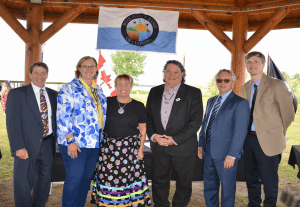
BOIS FORTE BAND REGAINS HISTORIC TRIBAL LAND
Partnership between Band, The Conservation Fund, Indian Land Tenure Foundation restores ownership of 28,089 acres of reservation land lost more than 100 years ago
NETT LAKE, Minn. (June 7, 2022) — The Bois Forte Band of the Minnesota Chippewa Tribe, in partnership with The Conservation Fund and the Indian Land Tenure Foundation, along with its subsidiary Indian Land Capital Company (ILCC) announced today the completed purchase of land that restores to the Band more than 28,000 acres of land within the Nett Lake and Deer Creek sectors of the Bois Forte Reservation.
The Band’s acquisition of 28,089 acres previously held by timberland owner and lumber manufacturer PotlatchDeltic Corporation constitutes the largest restoration of land since the Nett Lake and Deer Creek sectors of the Bois Forte Reservation were established in Minnesota under the Treaty of 1866. Plans are underway for the Band to directly manage the restored lands under a forest management plan that emphasizes conservation and environmental protection balanced with economic and cultural benefits to the Band and its members.
“This is a historic day for the Bois Forte Band,” said Cathy Chavers, Chairwoman of the Bois Forte Band of Chippewa. “This acquisition represents the largest restoration of land to our Reservation since our ancestors secured what was to be our permanent and undisturbed homeland. This acquisition rights a historic wrong and returns lush forests to the Band to foster and protect in homage to our ancestors and as an inheritance to our future generations. On behalf of the Band, I offer the deepest thanks to all those who made this day possible, especially those at The Conservation Fund and the Indian Land Tenure Foundation, whose efforts have been instrumental in making this historic restoration happen.”
The Band entered into a treaty with the United States in 1854 that set aside a region around Lake Vermilion as a reservation, which was later defined through an 1881 Executive Order. In its 1866 Treaty with the United States, the Band reserved two additional sectors at Nett Lake and Deer Creek to serve as its permanent homeland. However, just 20 years later, the federal government changed course, dividing the Reservation land and selling it to timber companies and homesteaders under the General Allotment and Nelson Acts. PotlatchDeltic eventually came to own significant acreages on the Nett Lake and Deer Creek sectors of the Reservation.
While some land was restored to the Band in 1938 under the Indian Reorganization Act, control of significant swaths of land within the 111,787-acre Nett Lake and 22,927-acre Deer Creek sectors remained out of Band ownership. But an opportunity for the Band to regain 28,089 acres – 21% of the total land base within the Nett Lake and Deer Creek sectors – emerged after PotlatchDeltic sold most of its land in Minnesota to The Conservation Fund in 2020. The national environmental nonprofit acquired over 72,000 acres of forestland, including 28,089 acres within the Bois Forte Reservation (27,565 acres in Nett Lake and 524 acres in Deer Creek). Conversations between the Band and the Fund about the lands within the Reservation began shortly thereafter.
“This outcome honors the heritage of this land by reuniting it with the Bois Forte Band and ensuring its long-term stewardship,” said Larry Selzer, The Conservation Fund’s president and CEO. “As a mission-driven organization, we are focused on creating solutions for naturally and culturally important lands that make sense for the environment and communities. We respect the Band as the best possible caretakers for this forestland and celebrate together this historic milestone.”
The Band’s purchase was financed by the Indian Land Capital Company, a Certified Native Community Development Financial Institution (CDFI) providing alternative loan options to Native Nations for tribal land acquisition projects. ILCC is owned by the Indian Land Tenure Foundation, a national, community-based organization serving tribal nations and people in the recovery and control of their rightful homelands.
“As we work to ensure more Indian lands return to Indian hands, today’s announcement demonstrates a meaningful step on the long journey ahead,” said Cris Stainbrook, President of the Indian Land Tenure Foundation. “We are proud to have helped the Bois Forte Band reach this milestone moment and hope that it inspires many more like it throughout Indian Country. And, it reminds all of us that restoring land to Indian ownership, management and control is more than a hashtag, it is a reality.”
A combination of conservation incentive payments under the Minnesota Sustainable Forest Initiative Act, coupled with other sustainable revenue streams that can be derived from the forest, will allow the Band to fully fund this acquisition and promptly pay off the purchase price. Later, the revenue generated from the land will support the Band’s land acquisition and conservation efforts.
The Bois Forte Band, a federally recognized Indian tribe organized under the Indian Reorganization Act of 1934, has over 3,600 enrolled members. The Band’s governing body is the Bois Forte Reservation Tribal Council. Among its other duties, the Council works to identify opportunities to restore the Band’s historic land base lost to federal allotment policies in order to ensure proper stewardship of those lands, expand economic opportunities. and exercise greater control over the Band’s territory.
The Bois Forte Reservation includes three sectors: Nett Lake, Deer Creek, and Vermilion, which are located in parts of Minnesota’s Koochiching, Saint Louis and Itasca counties. The Nett Lake sector is known for its prolific production of high-quality and hand-harvested wild rice, which is of vital traditional, cultural, and economic importance to the Band and its members.
About the Bois Forte Band
The Bois Forte Band of Chippewa is a federally recognized tribe situated in northern Minnesota. The Band’s governing body is comprised of a five-member Council. The Band delivers government services to over 3,600 enrolled members who are located on-reservation, across the United States, and abroad. The Band provides government services through a variety of departments, including Bois Forte Health Clinic, Human Services, Police Department, DNR, Tribal Court System, Realty, Housing, Enrollment, Public Works, IT services, Accounting, Education and Human Resources. As the owner and operator of the Boys and Girls Club, Fortune Bay Resort Casino, the Y-Store, and the Nett Lake C-Store, the Band is one of the largest employers within its region. You can learn more about the Band by visiting its website at: http://www.boisforte.com/.
About The Conservation Fund
At The Conservation Fund, we make conservation work for America. By creating solutions that make environmental and economic sense, we are redefining conservation to demonstrate its essential role in our future prosperity. Top-ranked for efficiency and effectiveness, we have worked in all 50 states since 1985 to protect more than 8.5 million acres of land across the U.S., including nearly 392,968 acres in Minnesota. www.conservationfund.org
About the Indian Land Tenure Foundation
The Indian Land Tenure Foundation (ILTF) is a national, community-based organization serving American Indian nations and people in the recovery and control of their rightful homelands. ILTF works to promote education, increase cultural awareness, create economic opportunity, and reform the legal and administrative systems that prevent Indian people from owning and controlling reservation lands.
Media Contacts:
- Brian K. Anderson, Bois Forte Band of Chippewa, 218-753-7882, bkanderson@fortunebay.com
- Joshua Lynsen, The Conservation Fund, 301-675-7764, jlynsen@conservationfund.org
- Grant McGinnis, Indian Land Tenure Foundation, 320-808-7825, gmcginnis@iltf.org
Map & Images: https://bit.ly/3GBTERz
Watch a video of the historic ceremony.
This news release was originally published by the Bois Forte Band of the Minnesota Chippewa Tribe and is reshared here with permission.
————————————————
INDIAN LAND CAPITAL COMPANY REPORTS RECORD INVESTMENT IN 2021
Investors are expressing confidence in the future of Indian Country
Jan. 19, 2022
Little Canada, Minn. – The Indian Land Capital Company (ILCC) today reported significant growth in in its lending pool for Tribal economic development and land acquisition thanks to increased investment from a variety of organizations. ILCC raised more than $11.3 million in 2021, capital that is used to fund important projects in Native communities.
“This is significant news for Indian Country,” said Rjay Brunkow, Chief Executive Officer of ILCC and enrolled member of the Turtle Mountain Band of Chippewa Indians. “100 percent of the money – all $11.3 million of it – will directly support projects in Tribal communities in the coming months. The money goes into ILCC’s lending pool to be distributed in the form of loans to Native Nations with very attractive terms they can’t get anywhere else.”
The Indian Land Capital Company is a Native-owned, Certified Native Community Development Financial Institution (CDFI) providing alternative loan options to Native Nations for tribal land acquisition projects. Formed in 2005, ILCC is owned by the nonprofit the Indian Land Tenure Foundation. As a Native-owned and operated business, ILCC understands the unique needs of Native Nations and creates customized, flexible loan packages that suit the specific needs of the tribe and the unique circumstances of the purchase.
“There are so many financially sound projects ready to go in Indian Country. The challenge has always been acquiring enough capital to lend, and we have made significant strides in that area this year,” Brunkow said. “The need is there and now we are able to meet more of the demand for financing.”
A variety of organizations and institutions made major investments in ILCC in 2021. These include:
- Associated Bank
- S. Dept. of Treasury Community Development Financial Institution
- CNote Group
- Opportunity Finance Network
- Oweesta
- Sunrise Bank
- Tamalpais Fund
“Investing in ILCC gives organizations a unique opportunity to make a real difference in the quality of life for an entire community,” Brunkow explained. “These funds will be invested in the construction of things like daycare facilities, clinics and cultural centers. We will be able to provide loans for economic development projects such as tribally owned convenience stores as well as land acquisition for future development.”
Although the confidence investors have shown in the future of Native communities and the work of ILCC is highly encouraging, the organization continues to aggressively pursue additional funding from a variety of sources. “This past year represents a big step forward in our efforts to raise as much capital as we possibly can on an annual basis, but there is a lot of work still to be done,” Brunkow said. “Capital is the most scarce resource in Indian Country and ILCC is fully committed to finding new and innovative ways to inject more capital into our communities.”
————————————————
ILCC RECEIVES NEARLY $3.5 MILLION IN FUNDING TO PROVIDE LOANS TO NATIVE AMERICAN ECONOMIC DEVELOPMENT PROJECTS
Dec. 9, 2021
Little Canada, Minn. – The Indian Land Capital Company (ILCC) has received nearly $3.5 million in funding in 2021 to support economic development projects and land recovery in Indian Country. The latest funding of $1 million was awarded to ILCC this week through the Community Development Financial Institutions (CDFI) Fund, which was created to promote economic and community development by empowering America’s underserved and distressed communities. The award to ILCC is part of the Native American CDFI Assistance Program (NACA).
“The impact of this funding will be significant in Indian Country,” said Rjay Brunkow, Chief Executive Officer of ILCC and an enrolled member of the Turtle Mountain Band of Chippewa Indians. “Our lending pool has grown substantially in the past 12 months, which has enabled us to fund more projects that contribute to economic growth in Indian communities.”
The Indian Land Capital Company (ILCC) was created in 2005 by the non-profit Indian Land Tenure Foundation (ILTF) to provide financing to Native nations for land acquisition on a full-faith-and-credit basis. “At any point in time we have more than a dozen fully-vetted, financially sound proposals in hand for projects that are ready to get started.” Brunkow explained. “The issue has always been acquiring enough capital to lend, and we have made significant strides in that area this year. The need is there and now we are able to meet more of the demand for financing.”
The NACA Program facilitates the creation and advancement of Native CDFIs such as ILCC, which predominantly serve Native American, Alaska Native, and/or Native Hawaiian communities. Through the NACA Program, the CDFI Fund awarded nearly $16 million in the fiscal year 2021 to 34 organizations in 16 states and the District of Columbia. In April, ILCC also received $1.8 million in special funding through the CDFI Rapid Response Program, which was created by Congress to deal with economic challenges in underserved communities that occurred due to the COVID-19 pandemic.
“There are so many opportunities in Indian Country, but tribal businesses and organizations continue to be underserved by traditional financial institutions,” Brunkow said. “The CDFI fund is a vital component that enables us to meet the needs of borrowers who otherwise cannot get funded.”
————————————————
INDIAN LAND CAPITAL COMPANY SUPPORTS THE 2021 INDIGENOUS BOWL
All-Star football game brings more than 60 Native American athletes together in Minnesota
Dec. 2, 2021
Little Canada, Minn. – The Indian Land Capital Company (ILCC) today announced its support of the 4th Annual Indigenous Bowl to be held Dec. 5, 2021 at U.S. Bank Stadium in Minneapolis. The event, which brings together more than 60 Indigenous high school football players from across the country, is a partnership between the 7G Foundation, the National Football League (NFL), and the Minnesota Vikings. The game is open to high school seniors who are tribal citizens.
“ILCC is committed to helping tribal communities recover their land and build their economies for the benefit of current and future generations,” said ILCC Chief Executive Officer Rjay Brunkow, who is a member of the Turtle Mountain Band of Chippewa. “By providing support for the Indigenous Bowl we are expressing that commitment in a tangible way. The future of Indian Country rests in the hands the next generation of leaders who have the kind of character, work ethic and team-first attitude that these athletes have.”
The game is hosted by the 7G Foundation, a group of entrepreneurs, coaches and tribal leaders who are dedicated to building on the strength of their ancestors to mold the next 7 generations of Native leaders through education, athletics, culture and real-world support. This year the Vikings, who are long-time supporters of the Native American community, and the NFL became partners with the Indigenous Bowl.
The rosters include players from 16 states and Canada who are members of 37 different tribes. “It’s great to see so many different communities represented,” said Brunkow, who played football at South Dakota State University. “As a Native-owned and operated business, we understand the needs of Indian tribes. We understand and support tribal sovereignty, and recognize the importance of building future leaders in Indian Country. This is a great opportunity to help do that.”
For more information on the event visit www.indigenousbowl.com.
————————————————
ILCC RECEIVES $540,000 AWARD FROM THE NATIVE AMERICAN CDFI ASSISTANCE PROGRAM
Oct. 1, 2020
Little Canada, Minn. – The Indian Land Capital Company (ILCC) has been awarded $540,000 through the Community Development Financial Institutions (CDFI) Fund which was created to promote economic and community development by empowering America’s underserved and distressed communities. The award to ILCC is part of the Native American CDFI Assistance Program (NACA), and it will have a significant impact in Indian Country.
“This award, coupled with other funds from ILCC’s lending pool, will allow our organization to assist a tribe in the Great Plains with land acquisition and the purchase of 250 head of buffalo. along with a meat processing plant,” said Rjay Brunkow, Chief Executive Officer of ILCC and an enrolled member of the Turtle Mountain Band of Chippewa Indians. “The buffalo and the processing facility will generate significant revenue for the tribe and create new jobs for tribal members in a part of Indian Country where jobs can be scarce.”
The NACA Program facilitates the creation and advancement of Native CDFIs such as ILCC, which predominantly serve Native American, Alaska Native, and/or Native Hawaiian communities. Through the NACA Program, the CDFI Fund awarded $15.2 million in the fiscal year 2020 to 40 organizations in 18 states. “As a Native-owned and operated business, ILCC understands the unique needs of Native Nations,” Brunkow said. “We can create customized, flexible loan packages that suit the specific needs of the tribe and the unique circumstances of the purchase.”
As part of the United States Department of the Treasury, the CDFI Fund fosters the creation and increases the capacity of community-based financial intuitions through investments and assistance, serving low-income people and communities that lack adequate access to affordable financial products and services. “The CDFI fund remains a vital component for Community Development Financial Institutions to meet the needs of borrowers who are unserved and/or underserved by traditional financial institutions,” Brunkow said.
Since its creation in 1994, the CDFI Fund has awarded more than $2 billion to Community Development Financial Institutions (CDFIs) around the country. By increasing funding to CDFIs that specialize in providing affordable credit, the CDFI Fund helps build businesses, create jobs, and revitalize communities.
————————————————

LINE OF CREDIT TO HELP ILCC SUPPORT ECONOMIC DEVELOPMENT, LAND RECOVERY FOR NATIVE NATIONS
From Aug. 20, 2019 edition of Native Business Magazine
As a for-profit, certified Community Development Finance Institution (CDFI), Indian Land Capital Company(ILCC) has made more than $20 million in loans to Native Nations without a single default or significant delinquency. Now a new $5 million line of credit from Associated Bank of Green Bay, Wisconsin, will help ILCC to further advance economic development and land recovery for Tribes — something ILCC will achieve by leveraging its unique approach to lending.
Unlike traditional lending institutions, ILCC makes loans to Native nations on a full-faith-and-credit basis. As such, ILCC does not require land to be used as collateral for the loan but rather encumbers alternative streams of income, including business or land revenue. The line of credit enables ILCC to offer Tribes more access to capital which is a glaring need, according to ILCC CEO Rjay Brunkow, a member of the Turtle Mountain Band of Chippewa
“As a Native-owned and operated business, we understand the needs of Indian Tribes,” said Brunkow. “We understand and support Tribal sovereignty, and recognize the importance of land to Indian people. As a result, we are able to create customized, flexible loan packages that suit the needs of the Tribe and the specific circumstances of the purchase.”
ILCC was created in 2005 as a partnership between the non-profit Indian Land Tenure Foundation (ILTF) and the Native American Community Development Corporation (NACDC) to provide financing to Native Nations for land acquisition.
“Associated Bank recognizes the benefits Indian Land Capital Company brings to the Native American community throughout the country,” said Relationship Manager Aaron Kessler. “It is our pleasure to partner with the organization in a meaningful way.”
Examples of projects ILCC has provided capital for include:
- A loan to the Menomonie Tribe in Wisconsin made it possible to improve the efficiency of its sawmill operation to improve air quality, generate electricity and efficiently heat the facility.
- A loan to the Little Traverse Bay Bands of Odawa Indians in Michigan enabled the Tribe to purchase a 311-acre farm adjacent to its reservation to develop a certified organic farm.
- Thanks to a loan from ILCC, the Scott’s Valley Band of Pomo Indians in Northern California has made a large investment in a bioenergy plant that uses burned timber from California wildfires to produce electricity and organic byproducts, which are then sold to generate valuable revenue
“Tribes like Scott’s Valley have difficulty accessing capital because they are perceived as lacking the resources to service the debt,” Brunkow said. “But if you really take a look at their financial situation you’ll find that they are easily able to service the debt, and are worthy of even more credit than what they have used to date. Thanks to our partnership with Associated Bank the Tribe was able to move forward on a great project.”
Photo courtesy of Facebook/Scotts Valley Band of Pomo Indians
————————————————
ILCC PARTNERS WITH ASSOCIATED BANK TO SUPPORT ECONOMIC DEVELOPMENT AND LAND RECOVERY FOR NATIVE NATIONS
August 16, 2019
Little Canada, Minn. – Economic development and land recovery are high priorities for Native American tribes. Thanks to a $5 million line of credit from Associated Bank of Green Bay, Wisc., the Indian Land Capital Company (ILCC) is using its unique approach to lending to help more Native Nations pursue both objectives.
“As a Native-owned and operated business, we understand the needs of Indian tribes,” said ILCC Chief Executive Officer Rjay Brunkow, a member of the Turtle Mountain Band of Chippewa. “We understand and support tribal sovereignty, and recognize the importance of land to Indian people. As a result, we are able to create customized, flexible loan packages that suit the needs of the tribe and the specific circumstances of the purchase.”
ILCC’s unique approach has enabled the organization to partner with innovative financial organizations to make a difference in Indian Country. “Associated Bank recognizes the benefits Indian Land Capital Company brings to the Native American community throughout the country,” said Relationship Manager Aaron Kessler. “It is our pleasure to partner with the organization in a meaningful way.”
Unlike traditional lending institutions, ILCC makes loans to Native nations on a full-faith-and-credit basis. As such, ILCC does not require land to be used as collateral for the loan but rather encumbers alternative streams of income, including business or land revenue. The line of credit enables ILCC to offer tribes more access to capital which is a glaring need, according to Brunkow.
Examples of projects ILCC has provided capital for include:
- A loan to the Menomonie Tribe in Wisconsin made it possible to improve the efficiency of its sawmill operation to improve air quality, generate electricity and efficiently heat the facility.
- A loan to the Little Traverse Bay Bands of Odawa Indians in Michigan enabled the Tribe to purchase a 311-acre farm adjacent to its reservation to develop a certified organic farm.
- Thanks to a loan from ILCC, the Scott’s Valley Band of Pomo Indians in Northern California has made a large investment in a bioenergy plant that uses burned timber from California wildfires to produce electricity and organic byproducts, which are then sold to generate valuable revenue
“Tribes like Scott’s Valley have difficulty accessing capital because they are perceived as lacking the resources to service the debt,” Brunkow said. “But if you really take a look at their financial situation you’ll find that they are easily able to service the debt, and are worthy of even more credit than what they have used to date. Thanks to our partnership with Associated Bank the Tribe was able to move forward on a great project.”
————————————————
ILCC TEAM WINS MAIBA GOLF TOURNAMENT TO SUPPORT NATIVE STUDENTS
Indian Land Capital Company turned in a score of 14 under par, good for 1st place in the 23rd annual Minnesota American Indian Bar Association (MAIBA) Golf Tournament. It was held at the Meadows at Mystic Lake Golf Course in the Shakopee Mdewakanton Sioux Community. “The team had great chemistry from the beginning, and we were able to play our best golf against stiff competition,” said Rjay Brunkow, the CEO of Indian Land Capital Company. “It’s a wonderful event, for a wonderful organization.”
The team was made up of Brunkow (Turtle Mountain Band of Chippewa), Greg Olson (Fond Du Lac Band of Lake Superior Chippewa), Clayton Kettelhut (Fond du Lac) and Nolan Pahmahmie (Citizen Band of Potawatomi). All proceeds from the event support the MAIBA scholarship fund, which benefits American Indian students attending Minnesota Law Schools.
————————————————
ILCC HELPS TRIBES RECLAIM ANCESTRAL LAND
From September 14, 2017 edition of The Circle – Native American News and Arts
By Lee Egerstrom
An unusual finance company based in the St. Paul, Minn. suburb of Little Canada is playing a big role in helping tribes repurchase ancestral lands that should never have been sold or taken away. The Indian Land Capital Co. (ILCC) is legally a for-profit venture owned by two nonprofit organizations, the Indian Land Tenure Foundation in Little Canada and the Native American Community Development Corp. of Browning, Mont.
There are a variety of legal reasons why the ILCC is incorporated that way, said Rjay Brunkow, chief executive officer. But mostly, it allows ILCC to work with commercial banks and other lenders to allow creative financing packages for tribes that aren’t secured by land collateral. “This has always been a problem for sovereign nations,” Brunkow said. “Lenders always want collateral supporting the loan. It takes some ‘getting used to’ for banks to recognize the full faith and credit (pledge) of sovereign nations.”
Founded in 2005, ILCC has helped tribes finance 17 land acquisition projects. The purchases have been in a dozen states but California is a major client base for ILCC activity. That comes from California’s large number of small Rancherias (reservations) and California Natives’ peculiar experiences with federal laws that disbanded the tribes and later restored federal recognition. Some ILCC loan have been small purchases of a few acres within reservation boundaries or a nearby mountain that has cultural importance but no economic value to a tribe. Others have been large purchases such as the 22,237 acres of timberland in 2011 that doubled the size of the Yurok Tribe at Klamath, Calif.
Land repurchases to date are important both economically and culturally but are a mere pittance of the 90 million acres pulled away legally and illegally from sovereign tribes, Brunkow said. The most recent ILCC financed land purchase was two months ago when the Pinoleville Pomo Nation at Ukiah, Calif., acquired 9.3 acres of its original Rancheria land with a $2.7 million loan. “We couldn’t have done this without Rjay’s and the land company’s help,” said Leona Williams, the tribal chairperson.
The reacquired land was split between 8.8 acres of commercial property and 3.5 acres that Williams described as “cultural heritage land.” All of the property, however, is significant for the Pinoleville Pomo citizens and for members of 16 other Rancherias in California, she said. Part of the land formerly belong to Tillie Hardwick, a tribal member who challenged a 1958 federal law that resulted in terminating the California Rancherias in 1966. In winning that 1979 case, tribal status was returned to the Rancherias and their members regained federal recognition as American Indians. “We really wanted to save this land but we didn’t have the means,” Williams said. “Then, an attorney we knew from Colorado suggested we find out if that group (ILCC) in Minnesota could help. It seemed to be too good to be true, but it was true.”
Small and less economically successful tribal nations like the Pinoleville Pomo make the primary client base for ILCC financing and originated loans with other partners. The Mille Lacs Band of Ojibwe and the Shakopee Mdewakanton Sioux Community “really don’t need our help,” he said, and they have all the internal expertise they need to work financing and business ventures.
Meanwhile, Brunkow said the capital company is gaining access to participating lenders with each passing land deal. The track record with tribes is what does it. “We’ve never had a tribal client default on a loan,” he said.
That would impress bankers. Brunkow would know. Brunkow, a member of the Turtle Mountain Band of Chippewa in North Dakota, is a former investment banker specializing in Indian Country business for Wells Fargo. He has a business economics degree from South Dakota State University and a law degree from the University of Minnesota. Before joining ILCC two years ago, Brunkow had previously served as solicitor general for the Mille Lacs Band of Ojibwe and as chief legal counsel for the Turtle Mountain Band.
One reason for the success of ILCC’s loans is that Brunkow and his predecessors serve as the loan originators when bringing other participants in on the loans. “When we know Indian Country, we know what will be done with the land and we know the politics, the culture of a tribe, that tells us the tribe will follow through on obligations,” he said. That isn’t significantly different from other banking and lending practices. “What we are looking for is stability,” he added.
ILCC is housed at the Indian Land Tenure Foundation office in Little Canada. It also gets staff help from the parent organization. While the Foundation, with its 76 percent stake in the company, and its Native American Community Development Corp. partner could be taking profits out of the for-profit lending institution, it doesn’t. And it won’t, explains Chris Stainbrook (Oglala Lakota), president of the Foundation and board chair for ILCC. “ILCC was formed as a for-profit company to demonstrate to outside lenders that tribes are good credit risks and full-faith-in-credit lending to the tribes could work. It was not formed for the two non-profit owners to be supported by ILCC profits,” he said. “ILTF and NACDC will not take a single nickel out of ILCC until the 90 million acres of lost reservation lands are returned to Indian ownership, management and control,” he added.
That shows the magnitude of the work remaining for the capital company and its parents.
————————————————
SUNRISE BANKS INVESTS $900,000 WITH ILTF TO SUPPORT TRIBAL LAND ACQUISITION

August 17, 2017
Little Canada, Minn. – Sunrise Banks, an innovative leader in the financial services industry based in St. Paul, Minn., recently invested $900,000 with the Indian Land Capital Company (ILCC), which provides financing for Native American tribes to acquire, develop and secure tribal land for economic development and cultural preservation. Sunrise is a family owned national chartered bank that strives for financial inclusion for all, and provides socially responsible financial products and services.
“Sunrise Banks is a great community partner, and we are pleased that they believe in the future of Indian Country as much as we do,” said Rjay Brunkow, CEO of ILCC, a Native-owned and operated business. “Their investment will be part of our lending pool that enables Native nations to purchase land and develop their economies.”
Unlike traditional lending institutions, ILCC makes loans to Native nations on a full-faith-and-credit basis. As such, ILCC does not require land to be used as collateral for the loan but rather encumbers alternative streams of income, including business or land revenue. This enables tribes to process land purchases more quickly and efficiently, and avoid costly legal fees. “We support tribal sovereignty, and recognize the importance of land to Indian people,” Brunkow said. “As a result, we are able to create customized, flexible loan packages that suit the specific needs of the tribe and the unique circumstances of the purchase.”
Much like ILCC, Sunrise Banks is a socially responsible, mission-driven enterprise that is meeting the needs of the underserved. “Sunrise is committed to partnering with innovative organizations that understand the needs of the communities they serve,” said David Reiling, Sunrise Banks CEO. “Indian Land Capital Company is uniquely positioned to help Native American tribes achieve their goals, and we are pleased to support the important work that they do.”
ABOUT SUNRISE BANK
Sunrise Banks, N.A., based in St. Paul, Minn., seeks to radically change the way urban communities and underserved people thrive by empowering them to achieve their aspirations. Sunrise is certified by the U.S. Treasury as a Community Development Financial Institution (CDFI), a designation earned by approximately 100 banks nationwide. Sunrise Banks is also a member of the Global Alliance for Banking on Values and is a certified B Corp for its demonstrated commitment to transparent corporate governance and positive community impact. (www.sunrisebanks.com)
————————————————
PINOLEVILLE POMO NATION ACQUIRES SIGNIFICANT ANCESTRAL LAND IN UKIAH, CALIF.
July 24, 2017
Little Canada, Minn. – The Pinoleville Pomo Nation of Ukiah, Calif., recently reacquired two significant parcels of its ancestral land, thanks to financing from the Indian Land Capital Company (ILCC). The $2.7 million in loans enabled the tribe to purchase 9.3 acres within the boundaries of its original 1911 Rancheria – 3.5 acres of culturally important land along with 8.8 acres of valuable commercial property. “This ancestral land has tremendous historical significance for the Tribe,” said Tribal Chairperson Leona Williams. “Being able to reacquire the property means so much to our people.”
The 3.5-acre historic property was once owned by Tribal member Tillie Hardwick, whose family had resided in the area for generations. In 1958, Congress passed a law that terminated the Rancheria, causing the Pomo to lose federal tribal status. In 1979, Hardwick filed suit in U.S. District Court challenging the legality of the termination. Hardwick’s legal action led to the restoration of tribal status for 17 California rancherias, along with recognition of individual tribal members as American Indians.
Based in Minnesota, Indian Land Capital Company provides alternative loan options to Native nations for tribal land acquisition projects. “As a Native-owned and operated business, we understand the needs of Indian tribes,” said ILCC Chief Executive Officer Rjay Brunkow, a member of the Turtle Mountain Band of Chippewa. “We understand and support tribal sovereignty, and recognize the importance of land to Indian people. As a result, we are able to create customized, flexible loan packages that suit the specific needs of the tribe and the unique circumstances of the purchase.”
Unlike traditional lending institutions, ILCC makes loans to Native nations on a full-faith-and-credit basis. As such, ILCC does not require land to be used as collateral for the loan but rather encumbers alternative streams of income, including business or land revenue. “This enables tribes to process land purchases more quickly and efficiently, and avoid costly legal fees,” Brunkow said.
The 8.8-acre commercial property purchased by the Pinoleville Pomo Nation is the site of a former car dealership in Ukiah, located approximately 140 miles north of San Francisco. The Tribe had been leasing the property for five years for its business enterprises. Thanks to the loan from ILCC, the Tribe now owns the land and plans to construct a large gaming facility.
“We are grateful to ILCC for providing the financing to purchase both parcels of land,” said Chairperson Williams. “We will now be able to move forward with our economic development plans, which will help to secure the future of the Pinoleville Pomo Nation and our members.”
————————————————
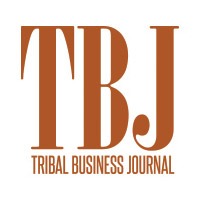
INDIAN LAND CAPITAL COMPANY: MAKING A DIFFERENCE IN INDIAN COUNTRY
From June 2016 edition of Tribal Business Journal
By Levi Rickert
Rjay Brunkow (Turtle Mountain Band of Chippewa Indians) enjoys what he does. As CEO of Indian Land Capital Company (ILCC), he provides money to tribes for economic development through loans. “There is nothing more satisfying than going home and knowing you have made a difference in Indian Country,” says Brunkow, who took the reins at ILCC in September 2015. “When I began a finance career working in Indian Country for Wells Fargo, then went on to work for the Mille Lacs Band of Ojibwe and the Turtle Mountain Band of Chippewa Indian tribes, I found satisfaction. Now I have found a sense of purpose by making loans to tribes.”
Prior to working in Indian Country, Brunkow graduated with honors from South Dakota State University with a Bachelor of Science in business economics, and earned his J.D. (cum laude) from the University of Minnesota Law School.
Founded in 2005, ILCC is a certified Native American Community Development Financial Institution (CDFI) based in Little Canada, Minn., that provides financing to American Indian tribes for land acquisition and economic development. It was formed as a collaborative effort between the Indian Land Tenure Foundation and the Native American Community Development Corporation of Browning, Mont., under the leadership of the late Elouise Cobell (Blackfeet) and Cris Stainbrook (Oglala Lakota), both strong advocates of tribal land acquisition.
Given the long history of American Indian Tribes losing land, ILCC plays a vital role when it comes to land acquisition. During the last several years, ILCC has provided financing so tribes can acquire land for a variety of reasons. From facilitating the Little Traverse Bay Bands of Odawa Indians’ purchase of 312 acres of land for organic farming in the northern part of Michigan’s Lower Peninsula, to assisting the Yurok Tribe in California obtain valuable lots of land for elder housing, ILCC helps tribes regain control over their assets, especially land, in order to promote tribal sovereignty, economies and culture. One of ILCC’s recent loans in particular gave Brunkow a real sense of pride: “We were able to help the Kashia Band of Pomo Indians in California purchase back land that the tribe lost 150 years ago,” he says. “The Tribe was ecstatic it was able to recover land it lost so long ago.”
“The Kashia Band of Pomo Indians has come full circle, once again regaining ownership of our coastal land,” says Tribal Chairman Reno Keoni Franklin. “We are proud owners of the Kashia Coastal Reserve, an environmentally protected property along the Northern California coast. It would not have been possible without the assistance of the Indian Land Tenure Foundation or the Indian Land Capital Company. Not only did they play a major financial role in our acquisition of the property, they also provided valuable advice and were a strong voice of empowerment when we doubted if we could complete the purchase.”
ILCC is unique in its lending practices in that it does not collateralize the land like other lending institutions; instead, it works out other ways to collateralize loans through other income sources of tribes. “In all the years we have operated, we have never had a default,” says Brunkow. “It is often difficult for tribes to obtain loans for land because many lending institutions are not familiar with Indian Country and what it means when land goes into trust by the federal government. We have an 11-year history of making loans. We know what we are doing. We think investing in Indian Country is a great investment.”
While ILCC began as a lending institution for tribes to acquire land, the company has expanded to finance other types of tribal projects. Some of the projects ILCC has funded include tribal administration buildings, strip malls on tribal lands and a tribal waste treatment plant. Brunkow says ILCC does not provide funding for gaming-related projects. Currently, ILCC provides loans to tribes in the $1.5 million to $2 million range. It has streamlined its process and tries to make it easy for tribes to get financing in an expedient timeframe. A tribe has to present its business plan and three years of audited financial statements. “We want a current snapshot of what is happening financially and we can move quickly,” Brunkow says. “Our turnaround time for a decision can usually come in less than a week.”
During Brunkow’s tenure, he wants to see ILCC grow in the number of loans it makes to tribes and even expand its service area. The company has yet to make a loan in Alaska, where over 200 tribes are located, and Brunkow would welcome an opportunity to provide financing to tribes there. “I see tremendous growth for Indian Land Capital Company,” Brunkow says. “It has a great history, and I see no reason that it should not be the first on the mind of tribal leaders when seeking a loan.”
————————————————
RJAY BRUNKOW APPOINTED TO LEAD INDIAN LAND CAPITAL COMPANY
Sept. 17, 2015
Little Canada, Minn. – After a rigorous selection process, the Indian Land Capital Company (ILCC) Board of Directors has announced that Mr. Rjay Brunkow has been appointed CEO of the firm. Brunkow takes over the helm at a time of high lending activity and demand. “Rjay brings a set of skills and attitude to the work that will help us build on the momentum that has been created. He started a month ago and he has already issued two loans to tribes for more than $2 million and started seeking more lending capital,” says Cris Stainbrook, ILCC board chair. “The Board believes Mr. Brunkow can take ILCC to the next several levels and his fast start is indicative of that.”
Founded in 2005 as a collaborative effort between Indian Land Tenure Foundation of Little Canada, Minn., and the Native American Community Development Corporation of Browning, Mont., ILCC is an American Indian owned and managed Native Community Development Financial Institution (Native CDFI) that has made a name for itself as a national lender to tribes.
“ILCC’s mission is to help Tribes regain control over their assets, especially land, in order to promote tribal sovereignty, economies, and culture,” said Stainbrook. “ILCC uniquely honors tribal sovereignty through its full faith and credit lending to Native Nations.”
Brunkow, an enrolled member of the Turtle Mountain Band of Chippewa Indians, comes to ILCC with a wealth of experience in Indian Country. Brunkow has previously served as an Investment Banker with a focus on government infrastructure in Indian Country. He has also served as Solicitor General for the Mille Lacs Band of Ojibwe, and as Chief Legal Counsel for the Turtle Mountain Band of Chippewa Indians. He has an extensive background in gaming and non‐gaming economic development projects within Indian Country. Brunkow earned his Bachelor of Science (with Honor) in Business Economics from South Dakota State University and his Juris Doctorate (Cum Laude) from the University of Minnesota Law School.
“I see this as an exciting opportunity to grow a new lending model in Indian Country – one that recognizes tribal sovereignty, does not require land as collateral and engages with the Native nation to find a financing package that works for them,” Brunkow said. “I am very excited to be part of this effort.”
Since inception, ILCC has made a total of more than $14 million in loans to 15 Native nations aiding in the recovery of approximately 35,300 acres to Indian ownership, management and control. The recovered lands have allowed for the acquisition and expansion of a health care facility, tribal resort, and an electric co‐generation plant, construction of homes for tribal members, management of sustainable forests, restoration of wetlands, and protection of sacred and cultural sites.
For additional information regarding ILCC, please contact Rjay Brunkow at rjay@ilcc.net or 651‐444‐5759. Cris Stainbrook can be contacted at cstainbrook@iltf.org or 651‐766‐8999.
————————————————
MICHIGAN TRIBE BUYS 311 ACRES FOR ORGANIC AGRICULTURE
Jan. 15, 2014
Little Canada, Minn. – An enterprising Michigan Tribe has tapped Indian Land Capital Company (ILCC) to finance a Tribal community farming project. The Little Traverse Bay Bands of Odawa Indians in Michigan has secured a $749,000 loan from ILCC to expand tribal lands, pursue agricultural projects, and promote the health and welfare of the Tribe. ILCC, a Native American owned and managed Native Community Development Financial Institution (NCDFI) based in Minnesota, developed an innovative financial agreement to help the 4,570-member Tribe in northern Michigan to purchase a former operating farm located adjacent to the traditional boundaries of the reservation. The site, which includes 311 acres of land, a house, barn, and outbuildings, will significantly advance the Tribe’s goal of promoting smaller family/ community gardens near where tribal citizens live, seed gathering and collection, and tribal gardening/farming operations that are certified organic and potential revenue sources from the sale of excess production.Land is especially significant to the Tribe that, despite numerous treaties promising both formal tribal status and Reservation land, was disenfranchised and dispossessed as a result of negligent federal policies that eventually eroded the entire tribal land base. The Tribe’s federal status was reaffirmed again only in 1994. Since then the Tribe has regained 848 acres of trust land in its aboriginal homeland, including the land on which the current Odawa Casino Resort, Tribal Administrative Buildings, Odawa Fisheries, Biindigen Gas Station, and proposed Mackinaw City Project are located.
“More than half of our tribal citizens live on or near our Tribe’s ancestral lands. These additional farm lands will help promote the general welfare and health of the Tribe by yielding quality foodstuffs for our people as well as a reconnection to our land,” said Tribal Legislative Leader Regina Gasco Bentley. “The ILCC loan provides both financial flexibility and strong commitment to tribal sovereignty, factors critical to our Tribe and project.”
ILCC provides flexible financing to strengthen Native communities and cultures through tribal land acquisition. The Native Company serves market niches underserved by traditional financial institutions, promotes community development, and provides technical support in conjunction with its financial activities. It lends on the “full faith and credit” of each individual sovereign Indian nation without requiring land to be used as collateral. Lending decisions are based on the full picture of a tribe’s financial condition, borrowing track record, and ability to make loan payments, eliminating the need for much of the costly and time-consuming measures required by traditional lenders to secure land and other assets as collateral for tribal loans.
“We were impressed by the Tribe’s high level of competence, commitment, and visionary leadership,” said Gerald Sherman, ILCC President and CEO. “We’re delighted to be partners in this exciting endeavor.”
————————————————
WELLS FARGO RENEWS INVESTMENT IN ILCC, FUNDS ASSIST RECOVERY OF SACRED SITE PE’ SLA
Oct. 10, 2012
Little Canada, Minn. – Indian Land Capital Company (ILCC), an American Indian Community Development Financial Institution (CDFI) specializing in financing tribes for land purchases, announced today that Wells Fargo has renewed its $750,000 investment to the capital loan pool. The loan was originally granted in 2006 to Indian Land Tenure Foundation (ILTF) which, along with Native American Community Development Corporation (NACDC), created ILCC as a collaborative effort in 2005. “As the first financial institution to invest in ILCC, Wells Fargo is pleased to renew this funding in support of ILCC’s work to promote community and economic development on tribal land,” said Megan Teare, Wells Fargo Community Lending and Investment. “We are proud to assist in the expansion of ILCC’s efforts and we look forward to seeing the positive impact from projects this investment helps fund in the years ahead.”
The loan renewal allows ILCC to continue investing the resources in tribal land recovery and community-based development projects for the next seven years. In September, using its current pool of funds, ILCC was able to loan Rosebud Sioux Tribe $900,000 for the earnest money to secure the $9 million purchase of the sacred site Pe’ Sla. Considered by the Lakota Nation to be one of its most holy sites, Pe’ Sla comprises 1,942 acres of land in the Black Hills that was privately owned by the Reynolds family, whose ancestors acquired the land in 1876. “We are truly grateful for Wells Fargo’s ongoing support of ILCC and their commitment to Indian Country,” said Gerald Sherman, ILCC president. “Having these and other resources available allowed us to act fast in order to help the tribes of the Great Sioux Nation to secure a deal to purchase these sacred lands that otherwise would have been sold at auction to the highest bidder.”
Unlike most traditional lenders, ILCC does not require land to be used as collateral for a loan, but relies on the “full faith and credit” of the Indian nation. This approach is more appropriate for lending to sovereign nations and eliminates the need for much of the costly and time-consuming measures required by traditional lenders to secure land and other assets as collateral. Most importantly, the land ownership is not at risk going forward.
While the earnest money made it possible for the participating tribes to secure a deal to purchase Pe’ Sla, the sale will not be final until November 30, 2012 and several of the details regarding the remaining $8.1 million in financing and cooperative land management have yet to be released. In addition to the Rosebud Sioux Tribe, several other Great Sioux Nation member tribes have made commitments to contribute funds for the land purchase. “Returning these sacred lands to Indian control is a major victory for the Great Sioux Nation, which never agreed to the sale of Pe’ Sla or any of the Black Hills in the first place. In essence, this was a purchase of the Reynolds family’s use rights, not land,” said Cris Stainbrook, ILTF president. “This sends a strong message that we can and will work together to recover and protect what’s rightfully ours.”
Other projects made possible through ILCC financing have included construction of elder housing and homes for tribal members, sustainable forest management, wetland restoration and protection of sacred and cultural sites. In August 2012, ILCC received a $725,000 Community Development Financial Institutions Fund (CDFI) grant awarded by the Native American CDFI Assistance (NACA) program. This was the second year in a row ILCC received this grant, the highest tier financial award given by the Treasury Department’s CDFI Fund. Since inception, ILCC has made nearly $7 million in loans to Indian nations, and has assisted in the recovery of approximately 30,000 acres of tribal land. ILCC’s long term goal is to substantially increase its loan pool and its capacity to make more and larger loans. In 2011, ILCC launched a campaign to raise $4 million in the first year with the goal of building a $100 million investment fund for Indian Country over the next 10 years.
————————————————
YUROK TRIBE DOUBLES LAND BASE WITH GREEN DIAMOND PROPERTY; TIMBER COMPANY SELLING TRIBE 22,000-PLUS ACRES OF LAND
From Eureka Times-Standard newspaper
April 15, 2011
The Yurok Tribe and Green Diamond Resource Co. finalized the purchase of 22,237 acres Thursday, doubling the tribe’s land base. The purchase is part of the tribe’s efforts to re-establish indigenous territory along the lower Klamath River. “The Tribe has long sought the return of ancestral land to create a salmon sanctuary and restore tribal cultural management practices, which benefit fish, wildlife and the ecosystem as a whole,” Yurok Tribal Chairman Thomas O’Rourke said in a press release.
Green Diamond Resource Co. Vice President and General Manager Neal Ewald said the purchase is a culmination of almost 23 years of collaboration between the tribe and the timber company, which began with the establishment of the Hoopa-Yurok Settlement Act of 1988. The act recognized some of the inequities between the two neighboring tribes and included sections within the act that attempted to redress the disparities, and include limited transfers of forest service land. “Our company is proud of our role in partnering with the Yurok and Western Rivers Conservancy to see this landscape moved into the tribe’s stewardship,” Ewald said in the release.
The land, more than 34 square miles, will become a Yurok Tribal Community Forest. The tribe said it will apply a sustainable forest management approach to the forest, protecting salmon, improving water quality and restoring meadows that traditionally supported subsistence hunting and gathering. Additionally, the tribe plans to further enhance three tributaries to the lower Klamath River that flow through the property: Pecwan, Ke’pel and Weitchpec Creeks. These creeks provide vital cold water and spawning grounds for the many Klamath fish species. The Yurok Tribe worked with the Western Rivers Conservancy to complete the purchase. “This is an historic accomplishment to ensure clean, cold water for the Klamath River’s salmon runs while re-establishing a portion of the Yurok’s homeland,” Phillip Wallin, the president of Western Rivers Conservancy, said in the release.
This land purchase is the first phase of the tribe’s plans for the community forest. The tribe’s future efforts also include plans for another possible land acquisition of nearly 25,000 acres from Green Diamond, and lobbying for the transfer of 1,200 acres on either side of the mouth of the Klamath River from the federal government.
